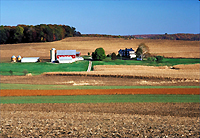|
The sad truth of the matter is that too many family farmers have already gone the way of the buffalo, and farm policy hasn't helped matters any. To the contrary, even a cursory examination of the figures shows that federal farm subsidies are, in fact, skewed toward big agribusiness, not local, family-run operations. According to USDA figures, 64 percent of America's farmers receive no direct government funding whatsoever. What’s more, from 1997 to 1999, the top 10 percent of those farmers who did receive payments from the principal farm program collected, on average, $96,000 per year as compared to $1,200 for the bottom 50 percent of recipients. According to the Environmental Working Group, Tyler Farms, an Arkansas partnership that controls 40,000 acres –- an area about the size of Washington, D.C. -– received $24 million dollars in federal subsidies over a period of 5 years. Does that smell a little peculiar to you? Well, it should. As the late Texas financier, Clint Murchison, once said: "Money is like manure. If you spread it around, it does a lot of good, but if you pile it up in one place, it stinks like hell." Well, while you’re chewing on that, here’s some more food for thought:
Figures collected from the report, "Food for Thought, The Case for Reforming Farm Programs to Preserve the Environment and Help Family Farmers, Ranchers and Foresters." Environmental Defense, 2001. Photo courtesy Tim McCabe, USDA. Up to Top |
 Rest assured that any time would-be reformers
challenge federal farm policy, the subsidies that are the hallmark
of that policy will be rigorously defended in the name of family
farmers. Without subsidies, legislators protest, that poor creature,
the family farmer, will become a thing of the past.
Rest assured that any time would-be reformers
challenge federal farm policy, the subsidies that are the hallmark
of that policy will be rigorously defended in the name of family
farmers. Without subsidies, legislators protest, that poor creature,
the family farmer, will become a thing of the past.